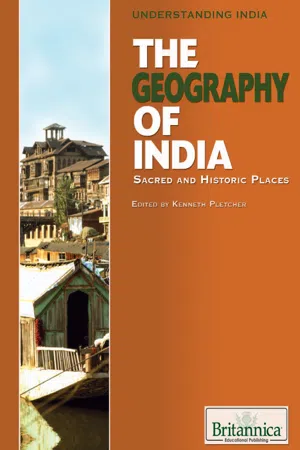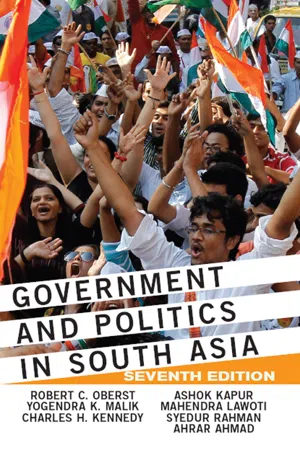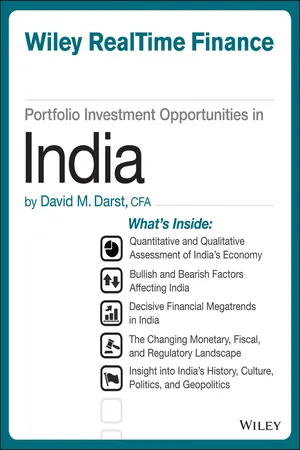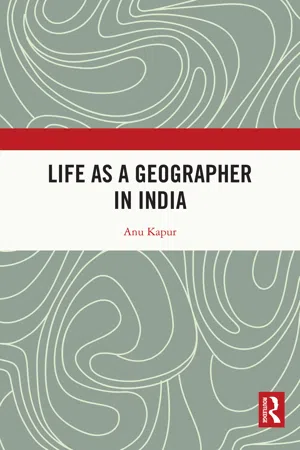Geography
India
India is a country located in South Asia, known for its diverse geography. It is bordered by the Himalayas to the north and the Indian Ocean to the south. The country features a wide range of landscapes, including mountains, plains, deserts, and coastal areas, making it one of the most geographically varied nations in the world.
Written by Perlego with AI-assistance
Related key terms
Related key terms
1 of 4
Related key terms
1 of 3
6 Key excerpts on "India"
- eBook - ePub
The Geography of India
Sacred and Historic Places
- Britannica Educational Publishing, Kenneth Pletcher(Authors)
- 2010(Publication Date)
- Britannica Educational Publishing(Publisher)
EOGRAPHIC OVERVIEWI ndia—officially Republic of India (Hindi: Bharat)—is a country that occupies the greater part of South Asia. It is a constitutional republic consisting of 28 states, each with a substantial degree of control over its own affairs; six less fully empowered union territories; and the Delhi national capital territory, which includes New Delhi, India’s capital. With roughly one-sixth of the world’s total population, India is the second most populous country, after China, and, in area, it ranks as the seventh-largest country in the world. India’s frontier, which is roughly one-third coastline, abuts six countries. It is bounded to the northwest by Pakistan, to the north by Nepal, China, and Bhutan; and to the east by Myanmar (Burma). Bangladesh to the east is surrounded by India to the north, east, and west. The island country of Sri Lanka is situated some 40 miles (65 km) off the southeast coast of India across the Palk Strait and Gulf of Mannar.The land of India—together with Bangladesh and most of Pakistan—forms a well-defined subcontinent, set off from the rest of Asia by the imposing northern mountain rampart of the Himalayas and by adjoining mountain ranges to the west and east. The most northerly portion of the subcontinent, the Kashmir region, has been in dispute between India and Pakistan since British India was partitioned into the two countries in 1947. Although each country claims sovereignty over Kashmir, for decades the region has been divided administratively between the two; in addition, China administers portions of Kashmir territory adjoining its border.Much of India’s territory lies within a large peninsula, surrounded by the Arabian Sea to the west and the Bay of Bengal to the east; Cape Comorin, the southernmost point of the Indian mainland, marks the dividing line between these two bodies of water. Two of India’s union territories are composed entirely of islands: Lakshadweep, in the Arabian Sea, and the Andaman and Nicobar Islands, which lie between the Bay of Bengal and the Andaman Sea. - eBook - ePub
- Robert C Oberst(Author)
- 2018(Publication Date)
- Routledge(Publisher)
PART I IndiaPassage contains an image 2 Political Culture and Heritage: A Changing Political Culture
I ndia’s difficulties in nation building, economic development, and political stability have been strongly influenced by a host of complex factors, most prominently its geographical setting, its sociocultural history, and a pattern of continuous external interventions. India is the largest state on the South Asian subcontinent. One-third the size of the United States—about 1,266,595 square miles—it is a country of great distances. From the Himalayas in the north to the Indian Ocean in the south, the distance is 2,000 miles, and it is some 1,700 miles from the western border with Pakistan to the eastern border with Burma. These distances and elevational changes mean that India has a wide variety of climates and landscapes, from snow-covered mountains and lush green forests to dry brown plains and sandy deserts.Geographically, India is divided into three main regions, each with its own culture, traditions, and history. The various subregions add to the country’s diversity of lifestyles and traditions. The first region consists of the vast plains of northern India, irrigated by the Ganges River and its tributaries. Originating in the Himalayas, the sacred Ganges runs more than 1,500 miles through several Indian states until it reaches the Bay of Bengal. The silt deposited by the river enriches the soil of the vast northern plains, where agriculture is the main livelihood of the people. In the Ganges Valley, the Hindu civilization flourished in ancient times.The second region, the Deccan Plateau, is separated from the north by the Vindhya Mountains and from the coastal areas by the Eastern and Western Ghats, which form a kind of mountain wall. Although rich in mineral resources, the plateau receives little rainfall; hence it is not heavily populated, in contrast to the other regions of India. In this region the people and the cultures of north and south intermingle. - eBook - ePub
Mapping Innovation in India's Creative Industries
Policy, Context and Opportunities
- Rohit K Dasgupta, Jennie Jordan, Graham Hitchen, Kishalay Bhattacharjee, Diviani Chaudhuri, Deepa D, Adrija Roychowdhury(Authors)
- 2023(Publication Date)
- Routledge India(Publisher)
7 The geography of Indian creative industries
DOI: 10.4324/9781032633336-7This deep dive provides a perspective on the geography of India, including a focus on two cities. At every turn in our research, we were reminded of the fact that India has features more like many countries rather than one, with very strong regional cultural traditions, multiple languages and strong regional/state governments. No study of the creative industries in India could be complete without a fuller understanding of that geography.Geographical and linguistic diversity
India is in many senses continental. It covers 3.287 million sq. km, 13 times that of the UK, and has a population of 1.4 billion people, 1.3 billion more than the UK. Divided by the Tropic of Cancer, its climate ranges from alpine in the Himalayas, to sub-tropical in the north, and equatorial in the south. As the 2013 Crafting a Livelihood report notes, ‘Production is generally seasonal, with crafts activity being suspended during harvest season, as most artisans are also engaged in agriculture to supplement their livelihoods’.1 The climatic differences create dramatic diversity in everything from the materials and styles of architecture to the stone used for sculpture and the vegetable dyes used for art, to the musical traditions of instruments made from specific woods and hides. Because of this geographic specificity, it is unhelpful to talk about ‘Indian leather-workers’ or ‘Metal working sculptors’ but rather to identify the particular creative tradition according to the geo-located identity of its creators – such as Bastar bell-metal work,2 Warli art3 and Pochampally Ikat weaves.4Across India there are multiple recognised languages with native-speaking populations numbering over one million, and at least 780 languages spoken in total.5 - eBook - ePub
- David M. Darst(Author)
- 2013(Publication Date)
- Wiley(Publisher)
, during the British Raj period.Until the end of the nineteenth century, the Indian subcontinent along with Southeast Asia was collectively known as the East Indies by European colonists and traders. The Indian subcontinent was referred to as Hither India (India Citerior) while Southeast Asia was known as Further India (India Ulterior).India’s Political System As of late-2013, India was composed of 28 states and 7 union territories, the latter of which are ruled directly by the national government rather than by a state legislature. Topography of IndiaIndia contains a veritable kaleidoscope of terrains. Its overall area encompasses just over one million square miles, yet the country offers a rich topographical diversity of varied climatic and ecological zones. The country possesses the highest snowbound mountain range in the world, the Himalayas to the north; the wettest spot on the planet, the Garo Hills of Meghalaya on the east coast; humid tropical forests in the southwest; the fertile Brahmaputra valley in the center; the low-lying mangrove swamps of the Sunderbans; and the Thar Desert with its ambient sand dunes toward the west.India’s terrain underscores its mystic and ethereal qualities, as prehistoric crystalline rocks and lava created plateaus and rivers that flow through the uneven western lands, forming picturesque lagoons and backwaters, and traversing cliffs and coastal vistas, all of which set a tantalizing backdrop for the aspirations and development of human society.Sanskrit and the Languages of IndiaSanskrit is the oldest language in the world. The word Sanskrit literally means “perfected language” or “language brought to formal perfection.” The Sanskrit alphabet is called devanagari - eBook - ePub
- Anu Kapur(Author)
- 2021(Publication Date)
- Routledge India(Publisher)
The political geography of India, and for that matter of any country, is the outcome of complex processes over time. The present cannot be understood without the understanding of the past. For instance, the schism between India and Pakistan, the churning in the Hindu society with the upward mobility of many castes, the regional variations in sub-cultures and politics etc. cannot be comprehended without taking the varied experiences of numerous localities and areas of society, economy, polity under different princes, kings, emperors, feudal landlords, etc. at different times along with the spread of different indigenous and foreign religions. The spatial differences in society, demography, culture, resources and economy over a physical base, and political structures and processes, and their interrelationships and interactions over time are reflected in the political geography of India. This book on the Political Geography of Contemporary India attempts to provide a comprehensive treatise on the above factors.I know the book would have been a delight to read.Innumerable notes under the general heading, “Book Support Material” can be classified into diverse subtitles of administration, militancy, globalization, geography and politics, political parties, society, history and archaeology, technology, strategy and power. Ideas get sharpened as readings are sifted and categorized. That the craft of geography had been mastered is all evident.The last half of the decade of the 1990s was perhaps the most prolific of his life. It was a creative decade for him. A sense of frustration and sadness does grip when one sees the exhaustive bibliography, several notes and articles, facts and data logged faithfully in his laptop with many a website awaiting a browse. An era of the trio of Professor R. Ramachandran, S.G. Burman, and Chandra Pal Singh in the Department of Geography, Delhi School of Economics comes to an end – a new one unfolds. While projects and infrastructure in the department could be pipelined and reinitiated in administrative routine, the crystal ideas have had to die with Chandra Pal. - eBook - ePub
Geopolitical Traditions
Critical Histories of a Century of Geopolitical Thought
- David Atkinson, Klaus Dodds(Authors)
- 2002(Publication Date)
- Routledge(Publisher)
Discovery of India (1981). For Nehru, ‘some kind of a dream of unity has occupied the mind of India since the dawn of civilisation’. He ‘discovers’ India’s unity as lying in culture and not in religion: hence no ‘holy land’ in his mental mapping of the country. For him the heroes of India’s history—Ashoka, Kabir, Guru Nanak, Amir Khusro, Akbar and Gandhi—subscribe to a variety of Indian faiths and it is Aurangzeb, the intolerant Moghul, who ‘puts the clock back’. India’s geography was sacred to Nehru not literally but metaphorically (Varshney 1993:236). Nehru’s secular nationalist construction of India stands in sharp contrast to the religious notion of India as originally the land of Hindus, and it is the only land which the Hindus can call their own (Pattanaik 1998:43–50). According to V.D. Savarkar, the ideological father of Hindu nationalism,a Hindu is he who feels attached to the land that extends from Sindhu to Sindhu as the land of his forefathers—as his Fatherland; who inherits the blood of the great race whose first and discernible source could be traced from the Himalayan altitudes of the Vedic Saptasindhus [the land of seven rivers] and which enabling all that was assimilated has grown into and come to be known as the Hindu people.(Savarkar 1969:100)What unites the Indian landscape is the sacred geography of Hindu holy places (Benaras, Triputi, Rameswaram, Puri, Haridwar, Badrinath, Kedarnath, and now Ayodhya) and the holy rivers (Cauveri, Ganga, Yamuna, and the confluence of the last two in Prayag).It is important to note that the boundaries of India as suggested by the secular-nationalist are coterminous with the ‘sacred geography’ of the Hindu nationalist whose hallowed pilgrimage sites mark off essentially the same boundaries of the country, although the Hindu nationalist would go much further into mythic history of more than two and a half millennia to date the origin of these sites. As Varshney remarks:Since the territorial principle is drawn from a belief in ancient heritage, encapsulated in the notion of ‘sacred geography’, and it also figures in both imaginations [secularist and nationalists] it has acquired political hegemony over time. It is the only thing common between the two competing nationalist imaginations. Therefore, just as America’s most passionate political moment concerns freedom and equality, India’s most explosive moments concern its ‘sacred geography’, the 1947 partition being the most obvious example. Whenever the threat of another break-up, another ‘partition’ looms large, the moment unleashes remarkable passions in politics. Politics based on this imagination is quite different from what was seen when Malaysia and Singapore split from each other, or when the Czech or Slovak republics separated. Territory not being such an inalienable part of their national identity, these territorial divorces were not desecrations. In India, they become desecrations of the sacred geography.
Index pages curate the most relevant extracts from our library of academic textbooks. They’ve been created using an in-house natural language model (NLM), each adding context and meaning to key research topics.
Explore more topic indexes
Explore more topic indexes
1 of 6
Explore more topic indexes
1 of 4





